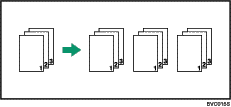
It is a popular choice for softcover books and thicker magazines and booklets. This booklet printing and binding process gives you a crisp, clean, and extremely professional-looking finished product. Once all of the pages are bound together, more adhesive is applied to the spine and then the cover is wrapped around them. Perfect bound refers to the process of grouping pages of booklets or books together and binding them with a thermal adhesive. For example, you might be preparing handouts for a class that you are teaching and you want to hand each page out separately at different times to your students. Non-collate printing is useful for times when you do not want your projects in numerical order. If you choose to not have your document collated, then the printer would print out 4 copies of page one, followed by 4 copies of page two and so on until you have all 7 pages copied.
Collate printer meaning professional#
The binding can be as simple as a single staple but for longer and more professional results, you can choose from a variety of binding methods. Usually, collated print jobs are also bound to keep the pages together. This type of printing is helpful when you want to have your projects printed out as a complete set. It would then repeat this process three more times until you have 4 complete sets of pages that are in numerical order. The printer would print one copy of page 1 then one copy of page 2 and so on until all seven of your first set are done.

If you choose to have it collated, then the following would happen. You have a 7-page document, and you want 4 copies made of that document. Here is an example to help illustrate the difference between collate printing and non-collate printing.

Difference Between Collate and Non-Collate Printing


 0 kommentar(er)
0 kommentar(er)
